pakistani gold necklace types
Pakistani Gold Necklace Types - Introduction
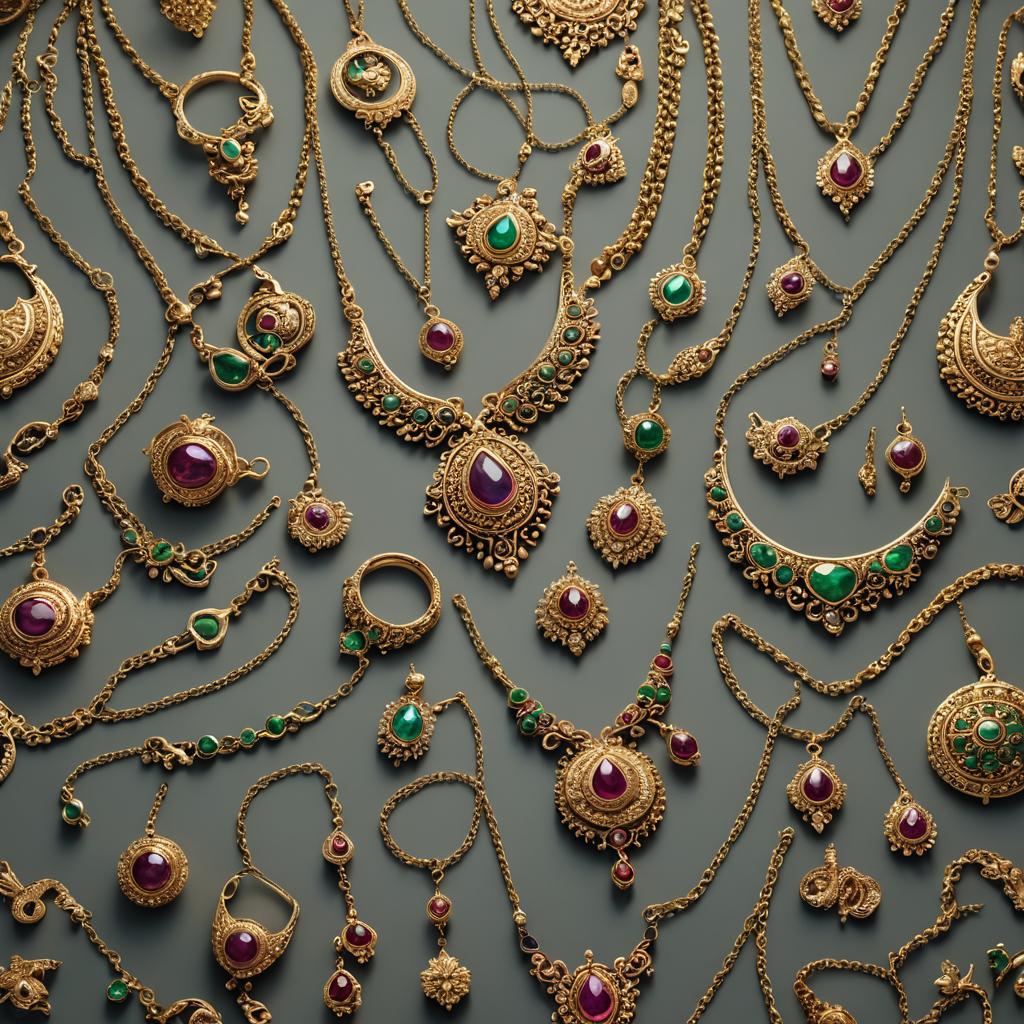
To write about the Pakistani Gold Necklace types is truly a pleasure. This page is dedicated to exploring the rich heritage and intricate craftsmanship of Pakistani gold jewelry. From the elegant Champakali and regal Rani Haar to the traditional Dholna Haar and versatile Guluband, each necklace type carries its own unique history and cultural significance. Some of these necklace types are common in the sub-continent probably due to the Mughal influence in the region.
Discover the detailed designs, origins, and traditional uses of these exquisite necklaces, and gain a deeper appreciation for the artistry that makes Pakistani gold jewelry truly special and makes the expertise of our women entrepreneurs designing the various ornaments truly appreciated.
Here we will start with the really old type of designs going on to the more later versions and contemporary necklace designs.
Pakistani Gold Necklace Types-Champakali
Description: Champakali necklace is a traditional Pakistani jewelry piece inspired by the Champa flower, known for its delicate and elegant petals. This necklace features a series of small, petal-shaped gold elements linked together to form a chain. Each petal is intricately crafted, often with fine detailing and embellishments such as enamel work or small gemstones. The design creates a beautiful, floral pattern that sits gracefully around the neck, embodying both simplicity and sophistication.
Origin: Champakali necklace has its origins in the rich cultural heritage of Pakistan, particularly in regions like Punjab and Sindh. The design is influenced by the natural beauty of the Champa flower, which is revered for its fragrance and delicate appearance. Historically, this type of necklace has been worn by women during special occasions, symbolizing elegance, femininity, and a connection to nature. Though not as commonly made as before, these necklaces continue to be cherished for their timeless beauty and cultural significance, embodying the fusion of natural inspiration and exquisite craftsmanship.
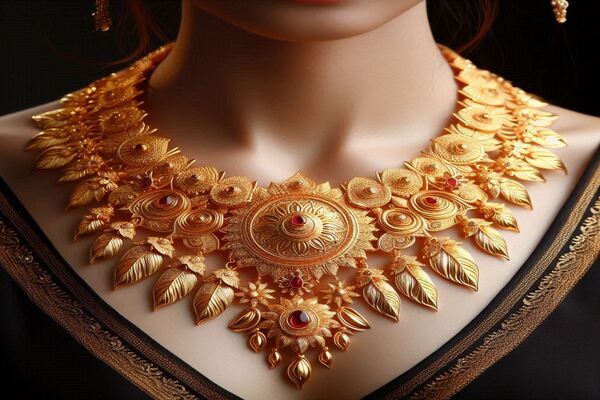
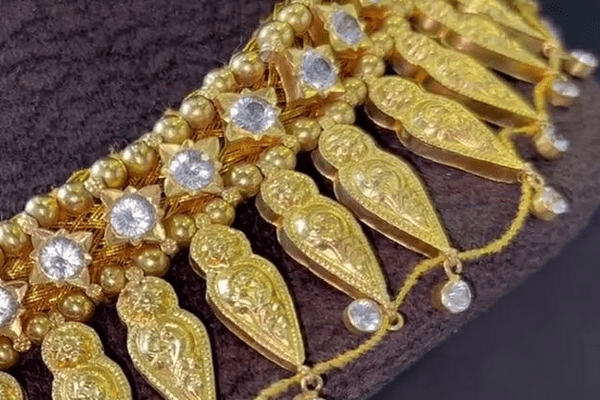
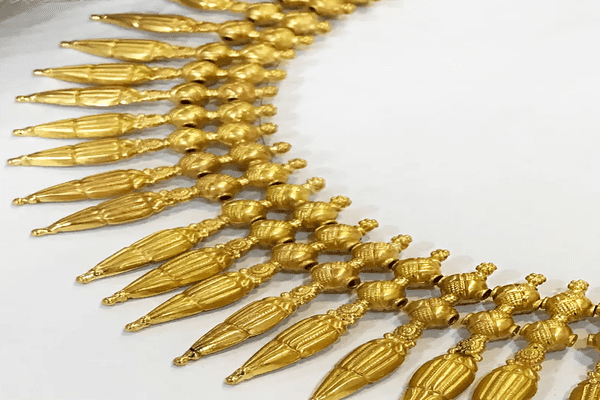
Pakistani Gold Necklace Types-Guluband
- Description: Guluband necklace is a traditional Pakistani jewelry piece characterized by its broad and decorative design. It closely resembles a choker but is wider and more ornate, featuring intricate floral motifs, geometric patterns, or embedded gemstones. The necklace sits snugly around the neck, making a bold and regal statement. There are many variations to the Guluband - some are pieces of gold stitched on velvet. It is often crafted from gold and may incorporate enamel work or small dangling elements for added elegance.
- Origin: Guluband necklace has its origins in the cultural heritage of Pakistan, particularly in regions like Sindh and Punjab. Historically, it was worn by women of noble families and aristocracy as a symbol of status and wealth. The name "Guluband" translates to "round the neck" in Urdu, emphasizing its snug fit and decorative nature. Pakistani artisans exhibit exceptional craftsmanship in creating Guluband necklaces, employing traditional techniques passed down through generations. Each piece is meticulously designed to reflect regional aesthetics and cultural traditions, showcasing the intricate artistry of Pakistani jewelry making.
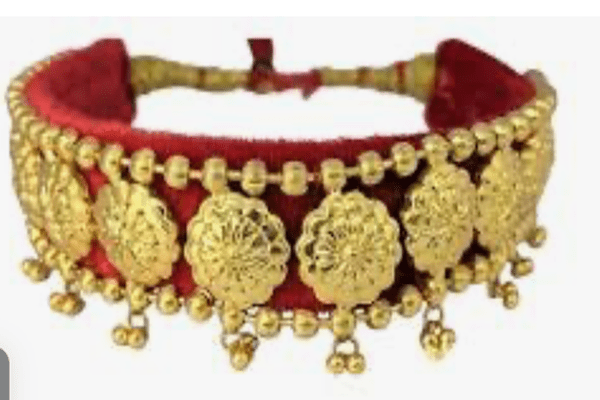
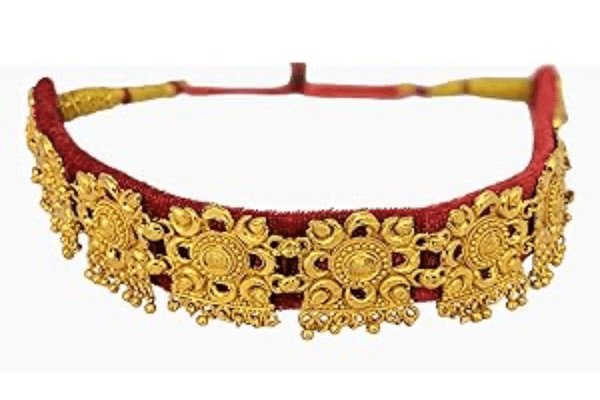
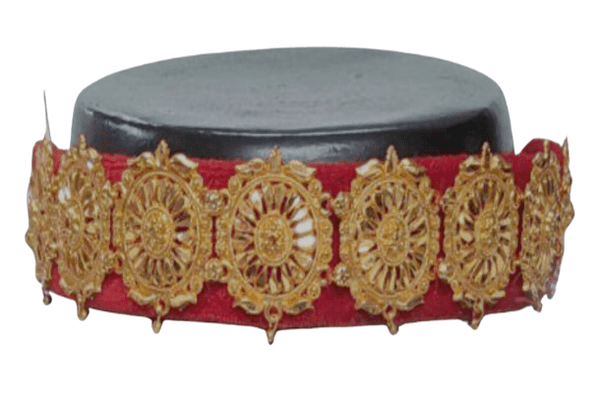
Pakistani Gold Necklace Types- Dholna Haar
- Description: Dholna Haar necklace is a distinctive Pakistani jewelry piece characterized by small, drum-shaped gold beads (known as "dholna") strung together to form a necklace. These beads are intricately crafted with detailed patterns, creating a unique and elegant design. The necklace can vary in length, from a choker style to longer chains, and is often adorned with additional elements like pearls, gemstones, or enamel work, adding to its ornate appearance.
- Origin: Dholna Haar necklace has its origins in Punjab and Sindh, Pakistan, where it holds cultural significance as a traditional adornment worn during weddings, festive occasions, and cultural celebrations. The name "Dholna" refers to the drum-shaped beads that are the hallmark of this necklace. Historically, it has been a symbol of prosperity and marital bliss, often worn by brides as part of their bridal jewelry set. Today, the Dholna Haar necklace continues to be cherished for its historical significance and aesthetic appeal, worn proudly to honor tradition and enhance the beauty of festive attire.
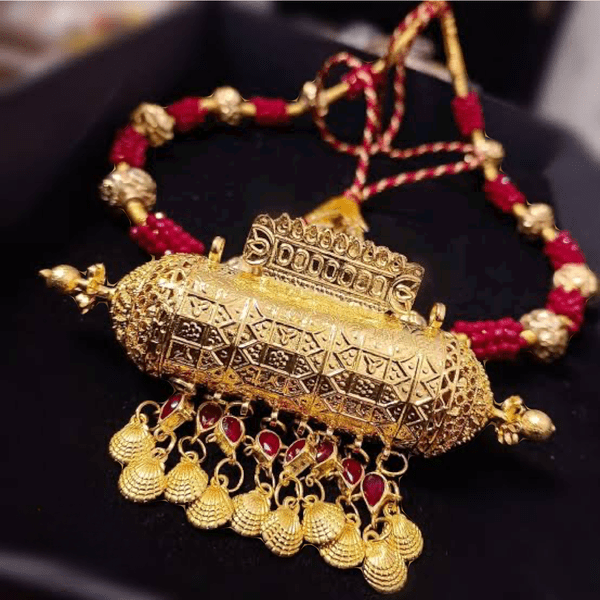
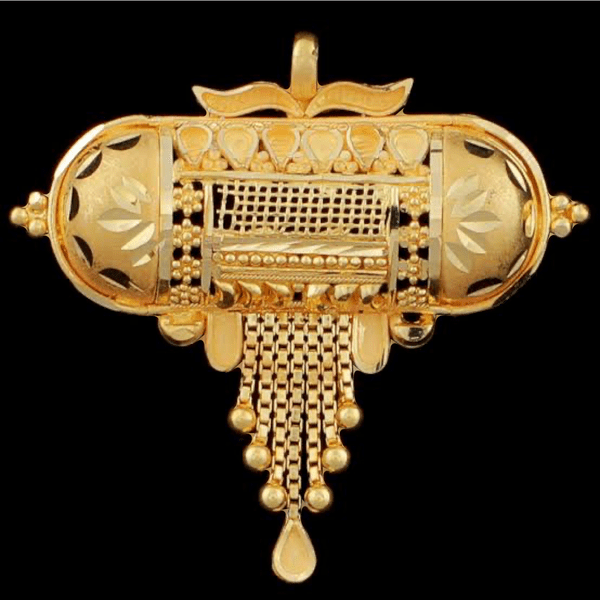
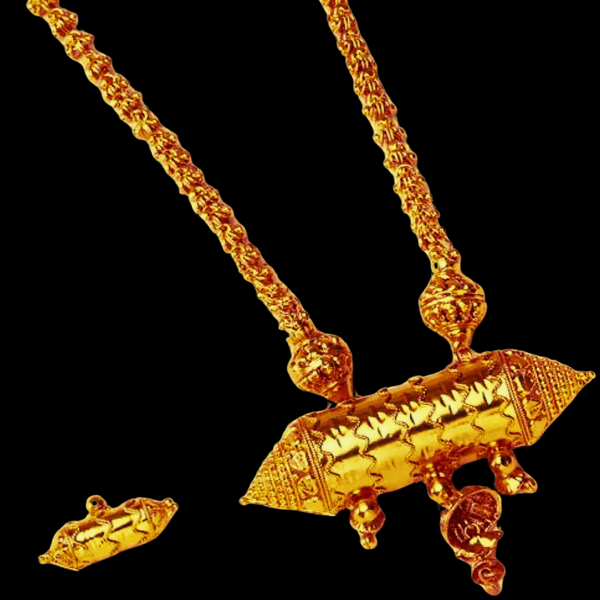
Pakistani Gold Necklace Types - Raani Haar
Rani Haar or Haar and its variations as Satlada, Panjlara and Teenlada:
- Description: Known as the "Queen's Necklace," rani haar is typically long and elaborate, often featuring multiple strands and detailed gold patterns. It may include precious gemstones. Various types are considered as rani haar that may include satlada, panjlada and teenlada.
- Haar is the general term used for any neckpiece. A long, elegant necklace featuring intricate designs and heavy gold work. Haars can be simple with minimal embellishments or highly ornate with detailed craftsmanship.
- Origin: Inspired by royal jewelry, rani haar is prevalent in regions like Punjab and is a staple in bridal trousseaus. Haar is Popular throughout Pakistan, especially in Punjab and Sindh, often worn during weddings and formal events.
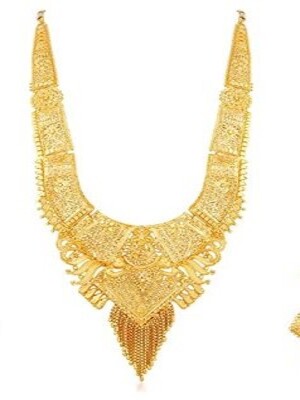
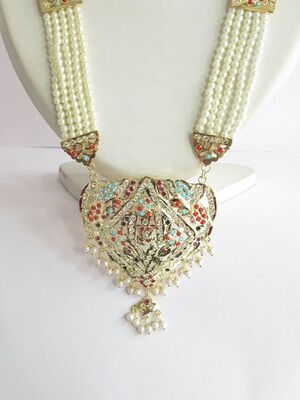
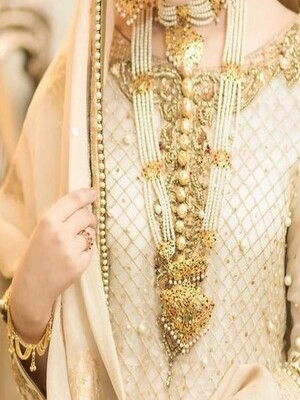
Satlada Necklace:
- Description: The Satlada necklace is an opulent and intricate piece characterized by its seven layers of pearls, gold beads, or gemstones. Each layer drapes gracefully, creating a cascading effect. The strands are often adorned with gold pendants, enamel work, and precious stones, adding to its grandeur and elegance.
- Origin: The Satlada necklace originates from the Mughal era, known for its luxurious and elaborate jewelry. Worn by royalty and nobility, it symbolized wealth and status. This tradition continues in regions like Punjab and Sindh, where it remains a popular choice for brides and cultural events. The Satlada is a testament to the meticulous craftsmanship and rich heritage of Mughal jewelry design, cherished for its historical significance and timeless beauty.
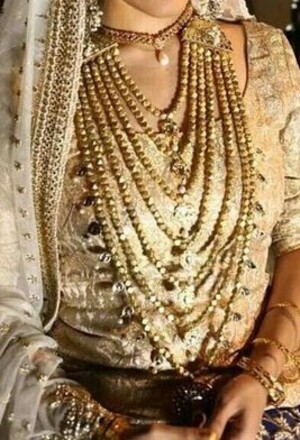
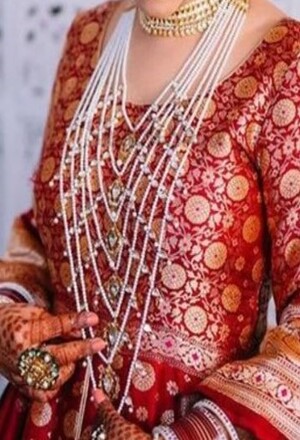
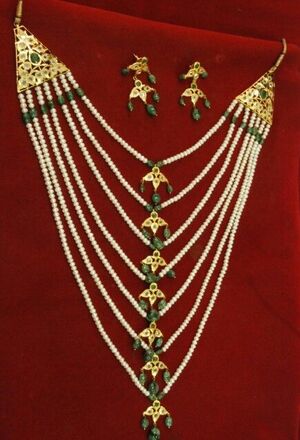
Panchlada Necklace
- Description: The Panjlada necklace is a traditional Pakistani jewelry piece characterized by its five layers of intricately designed gold chains. Each layer is adorned with intricate motifs, often incorporating floral or geometric patterns. The necklace is known for its opulent appearance, featuring small gold beads or pearls between the layers, adding to its elegance and charm. It typically sits gracefully around the neck, making it a popular choice for weddings and special occasions.
- Origin: The Panjlada necklace originates from Punjab, Pakistan, and is deeply rooted in the region's rich cultural heritage. "Panjlada" translates to "five layers" in Urdu, emphasizing the necklace's distinctive feature of multiple tiers of gold chains. Historically, it has been an integral part of bridal jewelry sets in Punjab, symbolizing prosperity, marital bliss, and familial heritage.
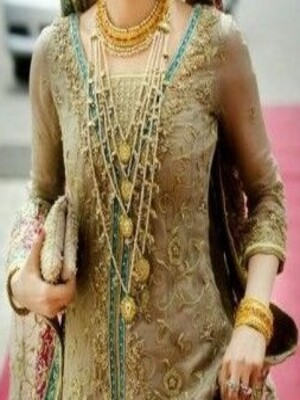
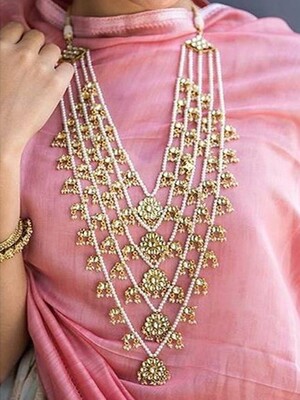
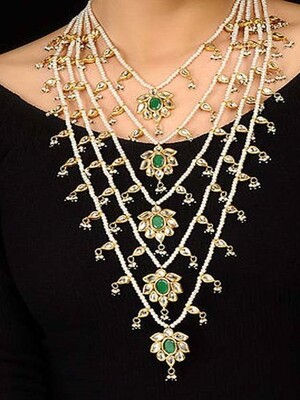
Teenlada Necklace:
- Description: The Teenlada necklace is a traditional Pakistani jewelry piece distinguished by its three layers of intricately designed gold chains. Each layer is adorned with delicate motifs, often featuring floral or geometric patterns. The necklace typically includes small gold beads or pearls between the layers, enhancing its ornate appearance and elegance. It sits gracefully around the neck, making it a popular choice for weddings and festive occasions.
- Origin: The Teenlada necklace originates from the cultural heritage of Punjab, Pakistan. "Teenlada" translates to "three layers" in Urdu, highlighting the necklace's distinctive feature of multiple tiers of gold chains. Historically, it has been an essential part of bridal jewelry sets in Punjab, symbolizing prosperity, marital bliss, and familial heritage.
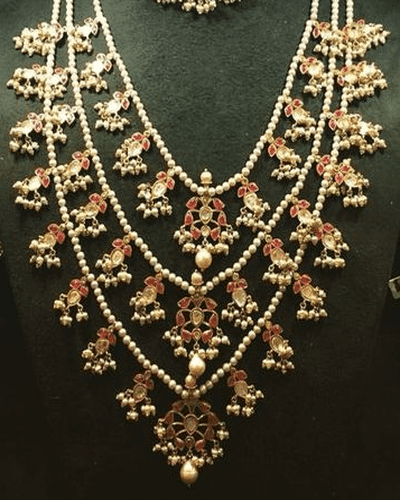
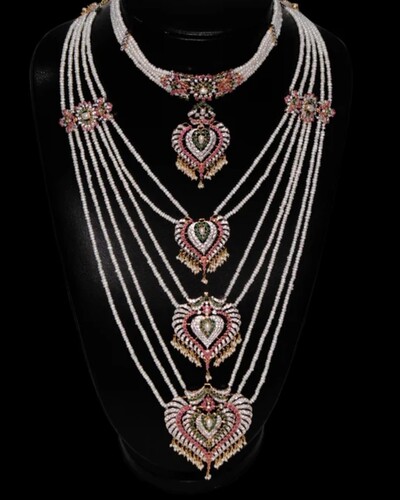
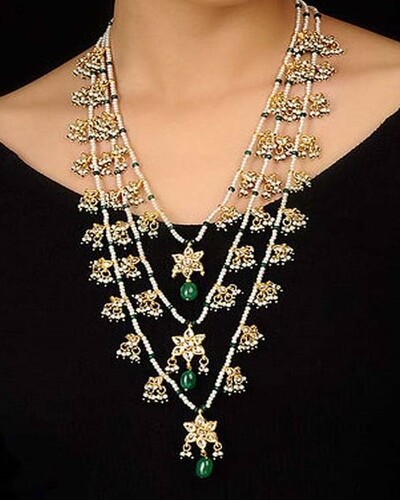
Pakistani Gold Necklace Types - Choker Necklace
- Description: A choker necklace is a close-fitting piece of jewelry that sits high on the neck. It is typically made of gold and may feature intricate designs, including filigree work, enamel detailing, or embedded gemstones like pearls or diamonds. Chokers come in various styles, from simple and elegant to elaborate and ornate, making them versatile for both casual and formal wear.
- Origin: The choker necklace has a rich history dating back centuries, worn by various cultures around the world. In Pakistan, chokers are particularly popular in urban areas and are crafted by skilled artisans who specialize in traditional jewelry making techniques. They have become a staple in Pakistani jewelry, often worn during weddings, festive occasions, and cultural events.
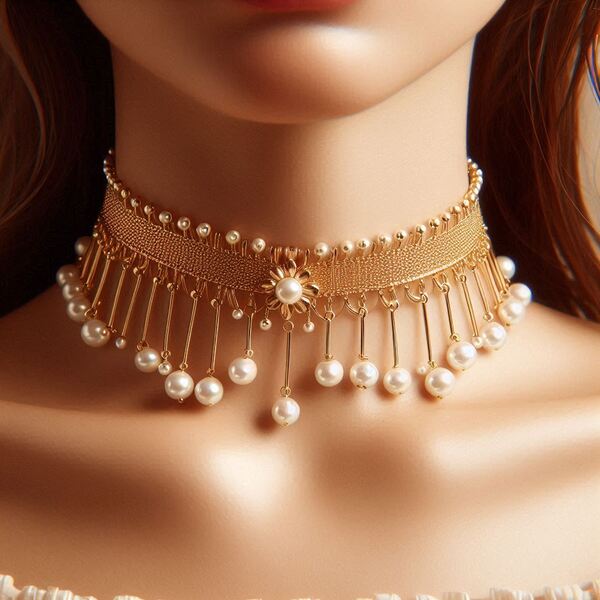
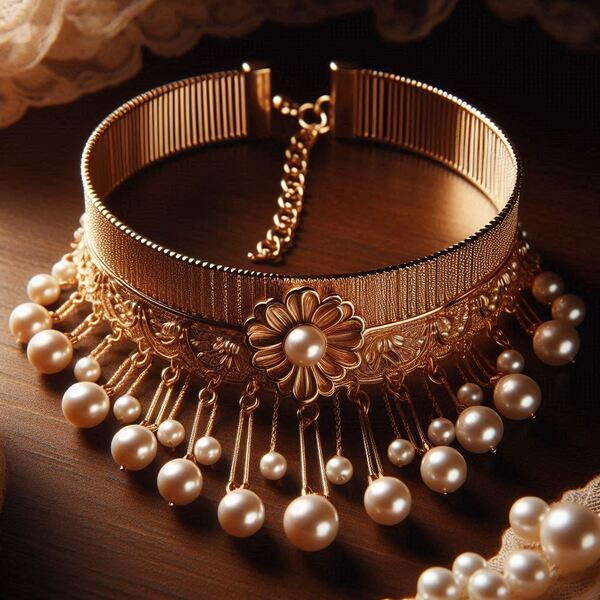
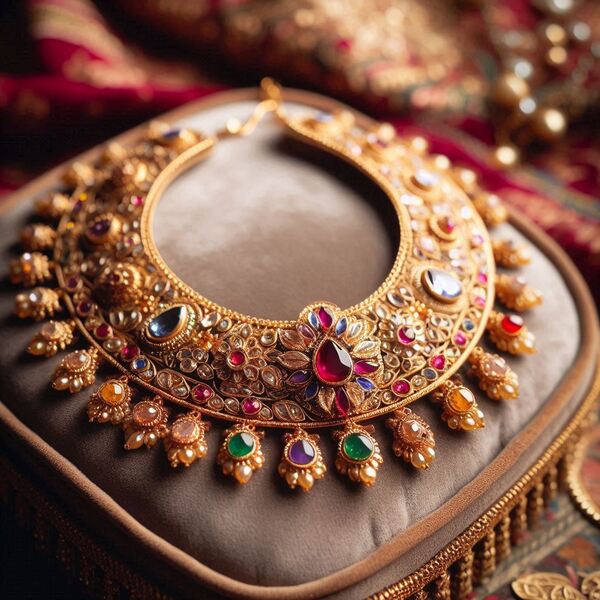
Pakistani Gold Necklace Types - Jhoomar Necklace:
- Description: Jhoomar necklace is inspired by the traditional headpiece worn on one side of the head, known as the jhoomar or passa. This necklace typically features cascading layers of gold chains, often adorned with pearls, gemstones, or intricate gold pendants. It is designed to mimic the elegance and charm of the jhoomar ornament, creating a luxurious and ornate look around the neck.
- Origin: Jhoomar necklace originates from the cultural heritage of Pakistan, especially prevalent in regions like Sindh and Balochistan. Historically, the jhoomar ornament was worn by brides as part of their bridal attire, symbolizing beauty and femininity. Over time, jewelers adapted the design into a necklace format, incorporating traditional motifs and craftsmanship.
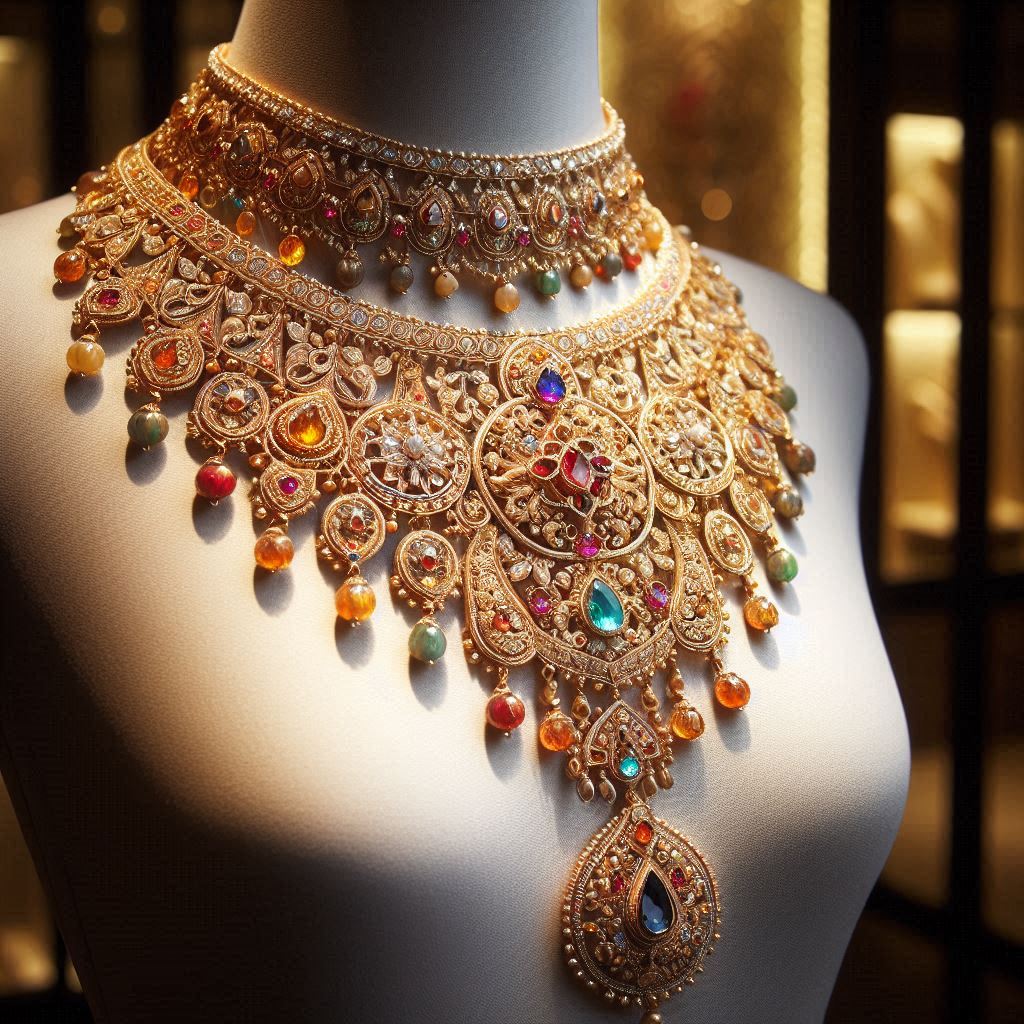
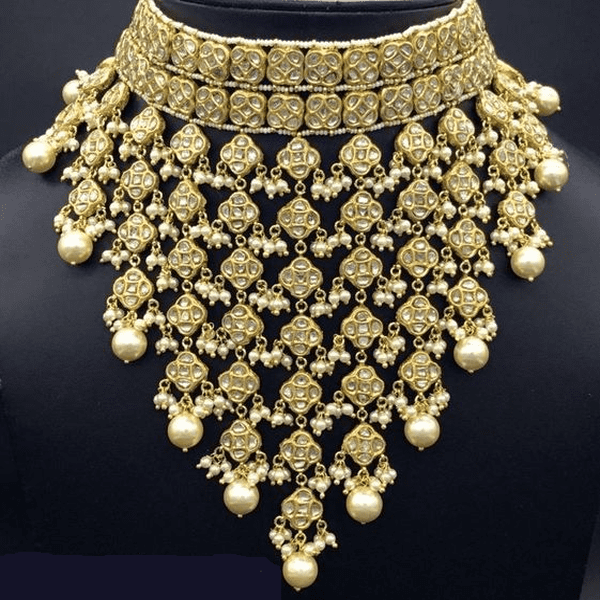
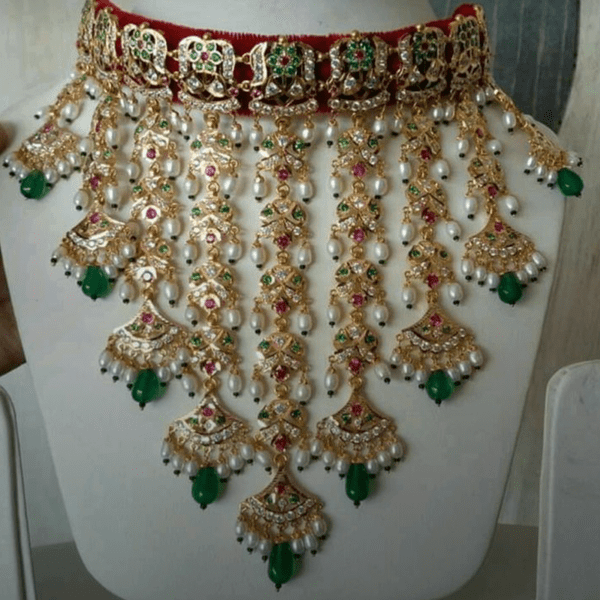
Pakistani Gold Necklace Types - Kundan & Polki Necklaces:
- Description: A highly ornate necklace featuring uncut diamonds and/or bilour set in gold. Kundan technique involves setting gemstones in a gold foil base, filled with lac (or laakh), a type of resin that is malleable with heat and has the ability to absorb color creating rich and intricate designs in the jewelry it is used.
- Polki necklaces are similar to Kundan but use unfinished natural diamonds (Polki) instead of uncut diamonds or bilour. The design is elaborate, featuring large, flat-cut diamonds set in gold, often combined with enamel work i.e. meenakari.
- Origin: Originating from Mughal jewelry traditions, Kundan necklaces are popular in northern Pakistan and among affluent families, often worn at weddings. Influenced by Mughal and Rajput traditions, Polki necklaces are cherished in Punjab and Sindh, especially for bridal wear.
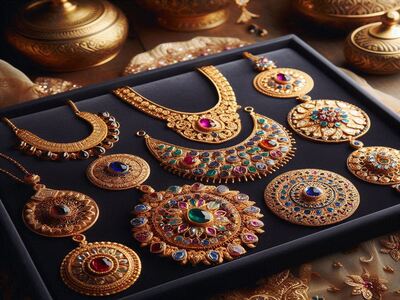
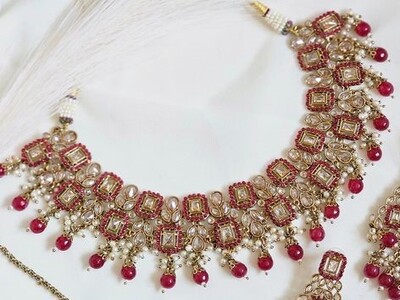
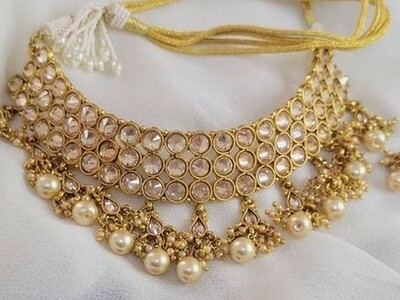
Pakistani Gold Necklace Types - Mala Necklace
- Description: Mala haar necklace is a traditional Pakistani jewelry piece that consists of a single or several strands of beads, often made from material such as gold, pearls, or gemstones. These beads are typically uniform in size and shape, strung together to form a continuous necklace. Mala necklaces can vary in length and may feature a pendant or tassel at the center. They are known for their simplicity and elegance, often worn as part of everyday attire.
- Origin: Historically, Mala necklaces have been crafted by skilled artisans who specialize in beadwork and jewelry making techniques. They are valued not only for their aesthetic appeal but also for their spiritual and cultural significance. In contemporary times, Mala necklaces continue to be worn as a form of personal expression and as a connection to tradition and spirituality, making them a meaningful accessory in Pakistani culture.
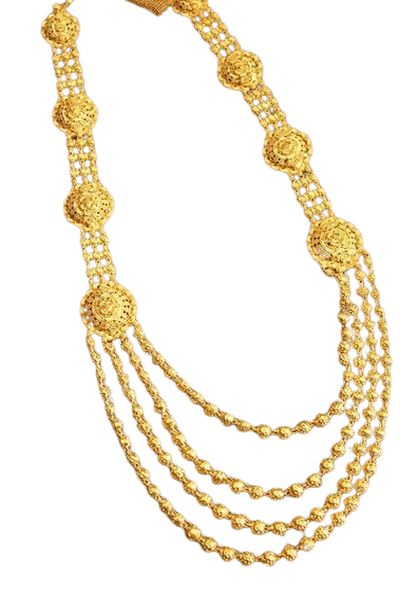
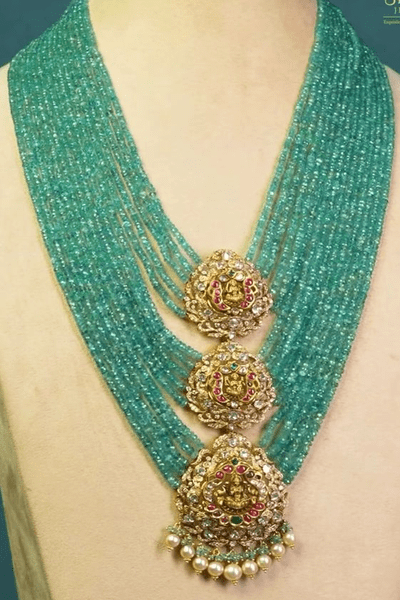

Pakistani Gold Necklace Types - Tassel Necklace
- Description: A tassel necklace is a decorative jewelry piece featuring one or more tassels hanging from a central pendant or necklace chain. The tassels are made of gold chains or beads, adding a modern touch to traditional designs, often embellished with beads, gemstones, or metallic elements. Tassel necklaces come in various lengths and styles, ranging from delicate and understated to bold and ornate, making them versatile for different occasions and fashion preferences.
- Origin: Tassel necklaces have a diverse cultural heritage, found in jewelry traditions across various regions worldwide. In Pakistan, tassel necklaces have been adapted into traditional and contemporary designs, reflecting local aesthetics and craftsmanship. Historically, tassels have been used in textiles and ornaments as decorative elements, symbolizing elegance and luxury.
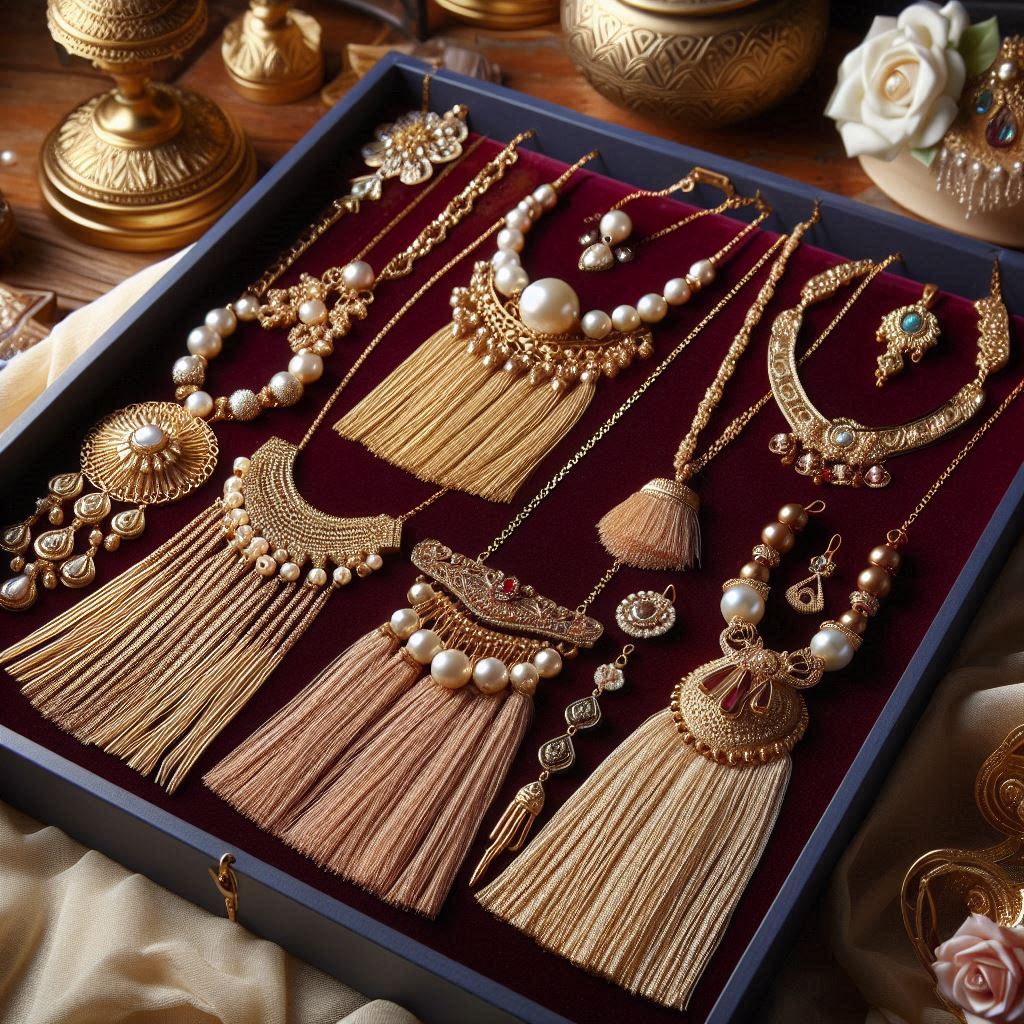
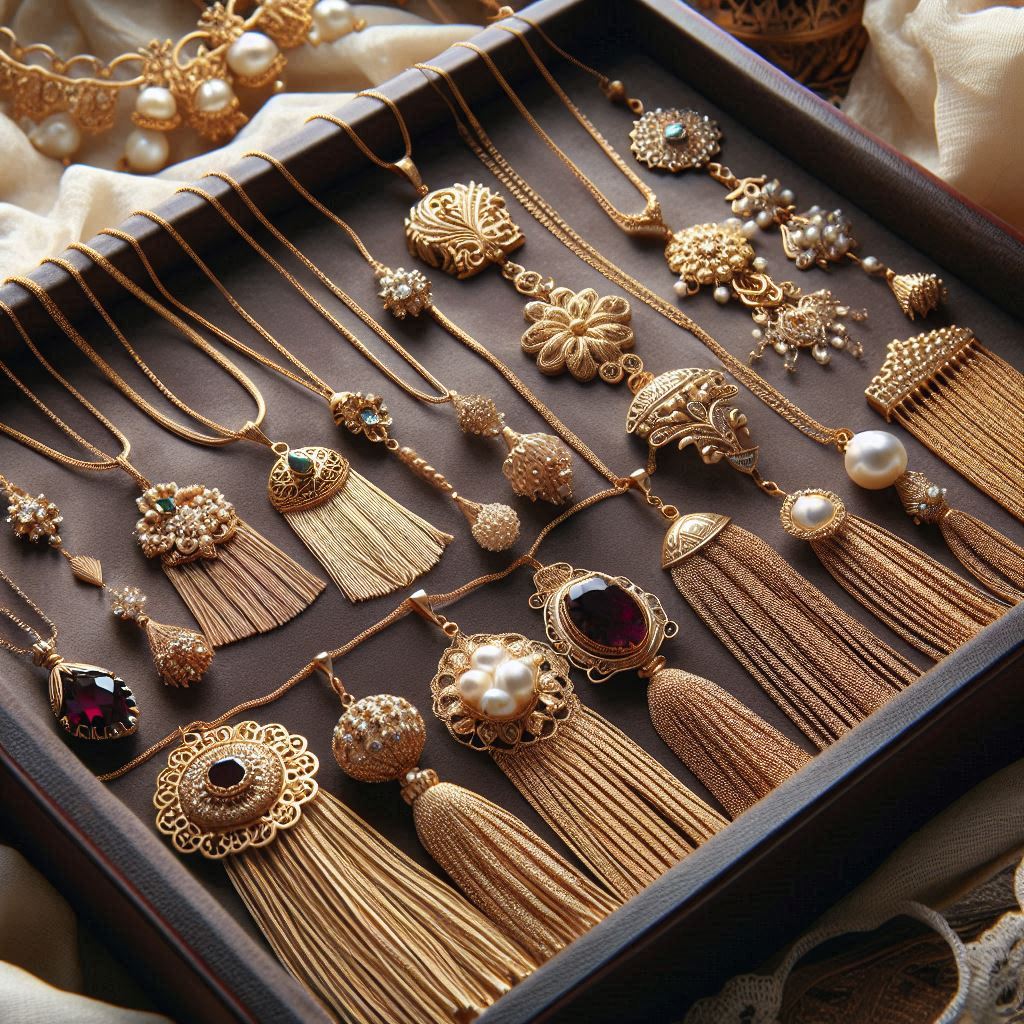
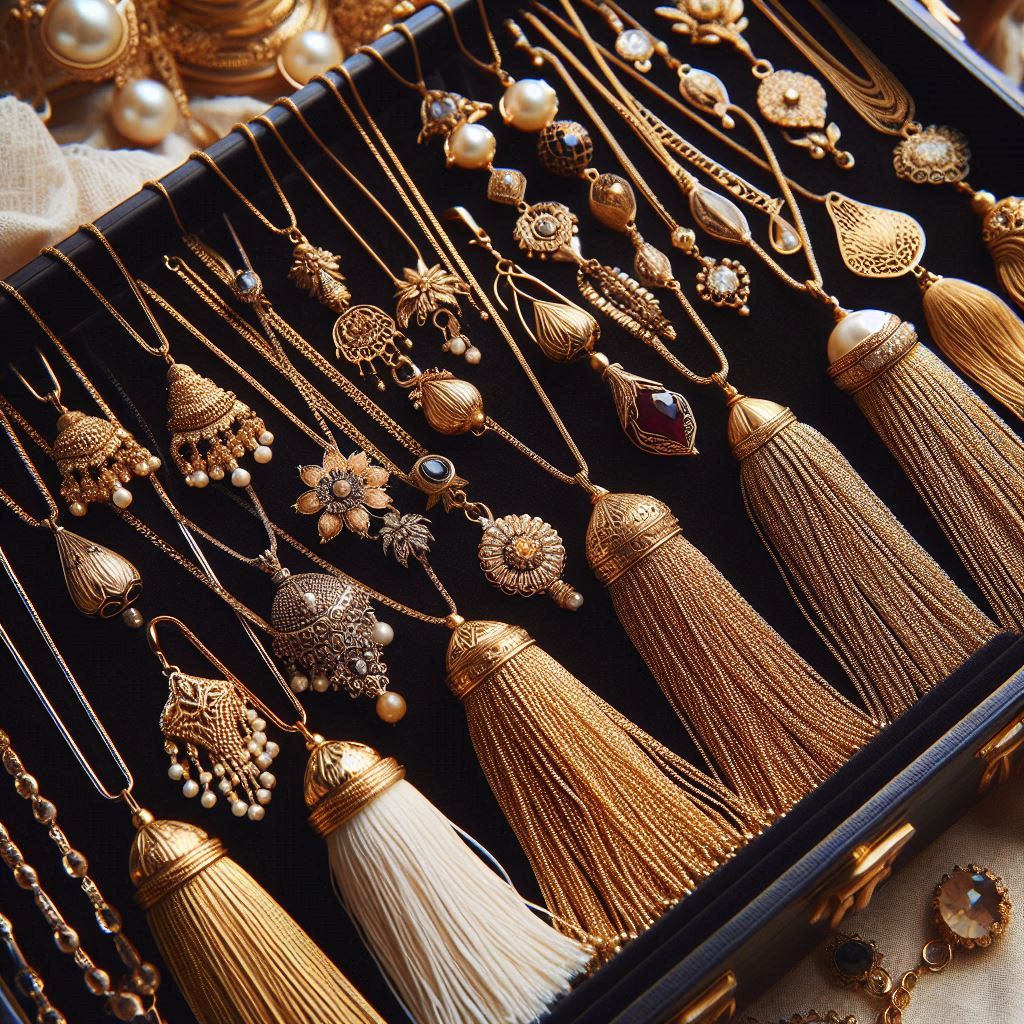
Pakistani Gold Necklace Types - Bib Necklace:
- Description: A bib necklace is a bold and statement-making jewelry piece that covers a large portion of the chest, resembling the shape of a bib. It typically consists of multiple strands or layers of beads, gemstones, or metal elements arranged in a structured and ornate design. Bib necklaces come in various styles, ranging from intricate and heavily embellished to minimalist and modern, making them versatile for both formal and casual occasions.
- Origin: Bib necklace has a global history, evolving from ancient jewelry traditions where such pieces were worn as ceremonial and status symbols. In Pakistan, bib necklaces have been adapted into traditional jewelry designs, often featuring intricate beadwork, enamel detailing, or precious stones that reflect regional aesthetics and craftsmanship.
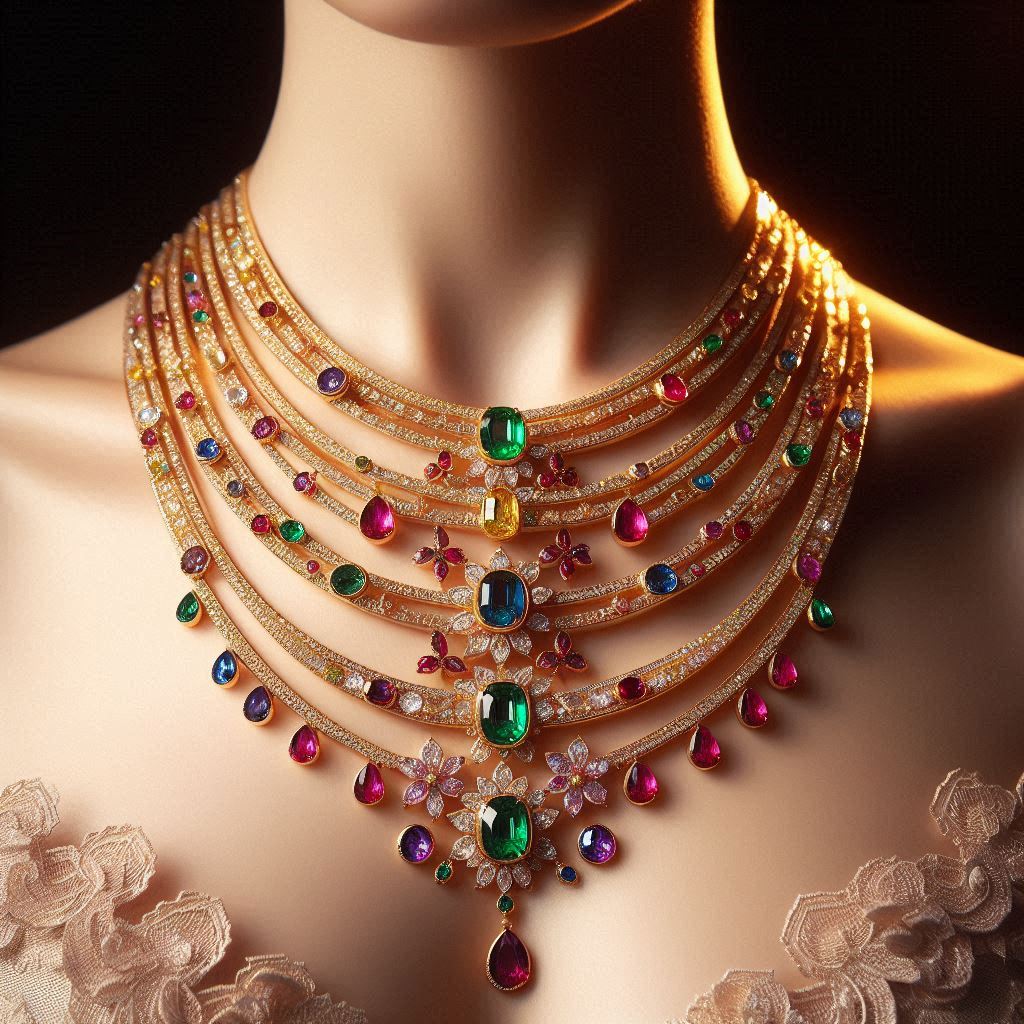
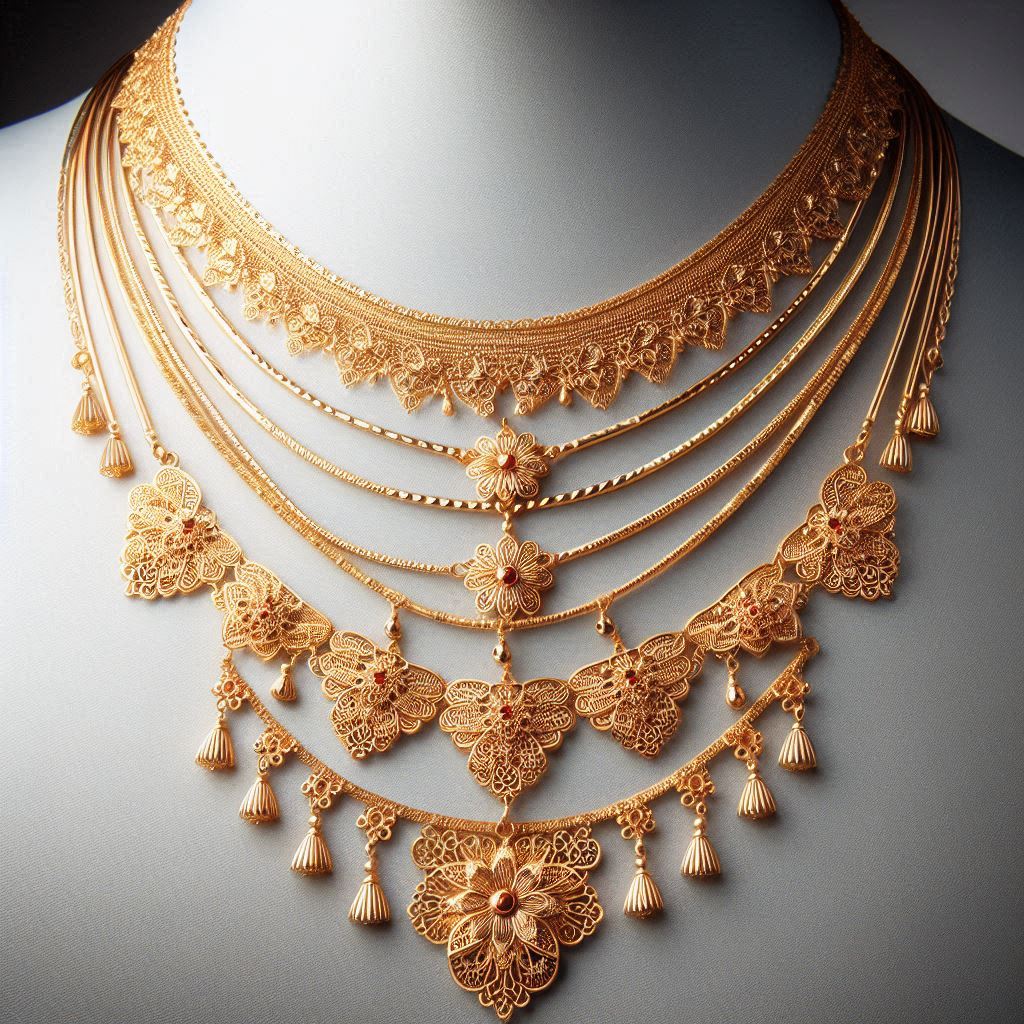
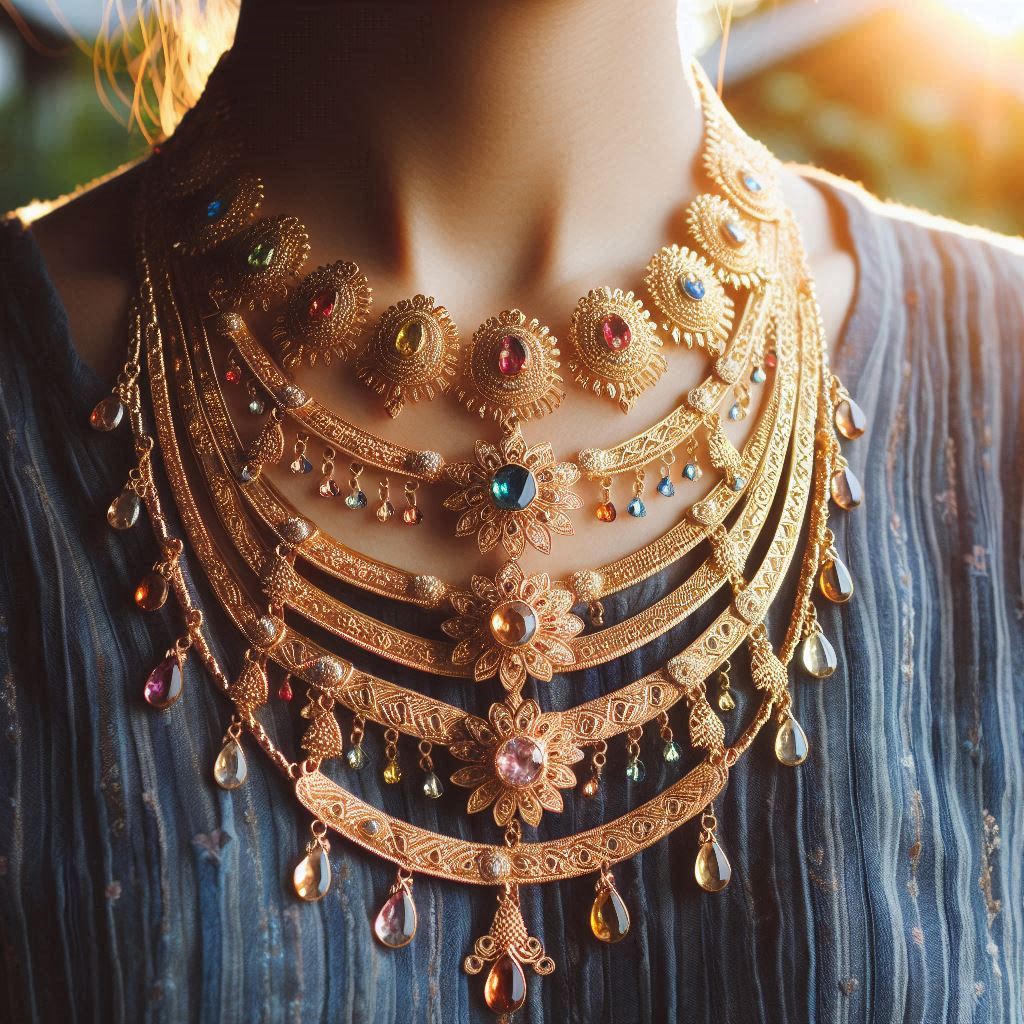
- Home
- Pakistani Jewelry
- Pakistani Gold Necklace Types


